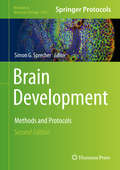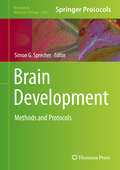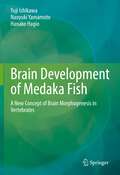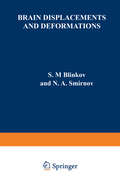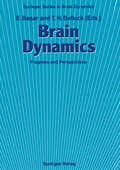- Table View
- List View
Brain Development: Normal Processes and the Effects of Alcohol and Nicotine
by Michael W. MillerThis is the first book about both normal development of the nervous system and how early exposure to alcohol and nicotine interferes with this development. The developing nervous system is highly dynamic and vulnerable to genetic and epigenetic factors that can be additive or synergistic. Disruption of normal brain development leads to an array of developmental disorders. One of the most common of these is mental retardation, the prime cause of which is prenatal exposure to alcohol. As chapters in this book show, alcohol has direct effects on the developing neural system and it affects genetic regulation. Another common neurotoxin is nicotine, and it is discussed in this book for three reasons: (1) the number of adolescents who smoke cigarettes is rising in some populations; (2) prenatal exposure to nicotine affects neurotransmitter systems that are critical for normal brain development and cognition; and (3) prenatal exposure to nicotine is often accompanied by prenatal exposure to alcohol.LThe mature brain is the culmination of an orderly sequence of the basic ontogenetic processes--cell proliferation, migration, differentiation, and death. Neural stem cells and progenitors proliferate in discrete sites; then, young neurons migrate long distances to their residences where they form neural networks. During this sequence many immature cells die, presumably eliminating unsuitable or non-competitive cells. Each process is regulated by genetic and environmental factors. When this regulation goes awry, a dysmorphic and dysfunctional brain results. Though this can be tragic in clinical settings, in experimental contexts it provides keen insight into normal brain development.LThe book is divided into three parts. The first describes neural ontogeny in the normal brain. The second and third deal with the consequences of early exposure to alcohol and nicotine. Though there are similarities in the effects of these two toxins, there are also intriguing differences. The commonalities reflect the plasticity and resilience of the developing brain while the differences point to the targeted effects of the two toxins. Exploring these effects brings a richer appreciation of brain development. The book will be of interest to neuroscientists, developmental biologists, teratologists, pharmacologists, toxicologists, neurologists, neuropsychologists, and to their students and trainees.
Brain Development: Methods and Protocols (Methods in Molecular Biology #2047)
by Simon G. SprecherThis book provides a thorough introduction to widely used techniques for the study of the intersection between developmental biology and neuroscience, an exceptional area to address and investigate impacting biological questions. The fully updated volume examines cutting-edge techniques on a representative range of animals, including widely used genetic model systems, such as the fruit fly, zebra fish, chicken, and mouse, as well as non-canonical experimental systems opened up through the advent of genome editing. Written for the highly successful Methods in Molecular Biology series, chapters include introductions to their respective topics, lists of the necessary materials and reagents, step-by-step, readily reproducible laboratory protocols, and tips on troubleshooting and avoiding known pitfalls. Authoritative and up-to-date, Brain Development: Methods and Protocols, Second Edition is an ideal guide for researchers interested in utilizing recent technical advances in molecular genetics for the study of the brain.
Brain Development: Methods and Protocols (Methods in Molecular Biology #1082)
by Simon G SprecherProviding widely used techniques in genetic model systems and many complementing animal models, Brain Development: Methods and Protocols focuses its expert contributions on two key technical aspects of developmental neurobiology: detection of gene expression and functional characterization of developmental control genes. Covering animal models such as the fruit fly, zebra fish, chicken, and mouse, this detailed book views in situ hybridization, reporter gene expression, and immunohistochemical staining methods, as well as RNA interference, Morpholino, or transgenic techniques through the prism of these models. Written in the highly successful Methods in Molecular Biology series format, chapter include introductions to their respective topics, lists of the necessary materials and reagents, step-by-step, readily reproducible laboratory protocols, and tips on troubleshooting and avoiding known pitfalls. Practical and cutting-edge, Brain Development: Methods and Protocols aims to provide precise technical protocols but also allows for comparing a wide range of protocols in different tissues and species.
Brain Development in Drosophila melanogaster (Advances in Experimental Medicine and Biology #628)
by Gerhard Martin TechnauBrain Development of Medaka Fish: A New Concept of Brain Morphogenesis in Vertebrates
by Yuji Ishikawa Naoyuki Yamamoto Hanako HagioThis book describes the developmental process of the brain of the medaka fish. It aims to understand the brain structure of vertebrates, including humans, by taking the brain of the medaka fish as an example and showing its actual developmental process. From developmental and evolutionary viewpoints, the understanding of the brain proceeds from simple to complex structures. Fish retain the basic form of vertebrates, and their brain morphology is relatively simple. Therefore, the fish brain is useful in understanding the brain structure. This book is unique for describing the entire process of the brain development in a specific fish. In addition, the book introduces the readers to a new concept of “Hourglass of Brain Morphogenesis”, concerning the general rule of brain morphogenesis in vertebrates. The authors propose that the brain morphology is highly conserved at the middle developmental stage but diverges more extensively at earlier and later stages. The new concept challenges the accepted theory that has been widely shared for about 200 years since K. von Baer (1828, 1837) and K. von Kupffer (1906) who proposed that three primary brain vesicles at earlier developmental stages develop into five secondary brain vesicles at later developmental stages in all vertebrates. The book provides a basic understanding of the vertebrate brain and is useful for all readers who wish to understand the complex structure of the brain.
Brain Displacements and Deformations
by S. M. BlinkovIn writing our book we had in mind both practicing physicians and scientif ic personnel. We hope that the former will benefit from an analysis of clinical symptoms and changes in the morphological substrate which produce them, and that the latter will be interested in facts illustrating the resistance of nervous tissue to compression and displacement, and in our concept of the primary role played by blood supply in the functional disturbances of a deformed brain stem. Although only a short time has elapsed since the first edition of the book, it has been necessary to introduce a number of addenda and corrections into the present edition. The chapter "Roentgenological Manifestations of Brain Displacements," written by N. S. Plevako and Z. N. Polyanker, has also been expanded. We are glad that a competent publishing house such as Plenum Press has undertaken the American publication of the book; we offer our sincere thanks to Mr. George Onischenko for his excellent translation; and we express our gratitude to Mezhdunarodnaya Kniga, the Soviet Book Export Agency, in the person of Galina Aleksandrovna Khudozhnikova, for their cooperation.
Brain Dopaminergic Systems: Imaging with Positron Tomography (Developments in Nuclear Medicine #20)
by B. Mazoyer J. L. Martinot L. Farde D. Comar J. C. BaronBrain Dynamics: Progress and Perspectives (Springer Series in Brain Dynamics #2)
by Erol Ba 351 Ar Theodore H. BullockThis volume is based on contributions to the second Brain Dynamics Conference, held in Berlin on August 10-14, 1987, as a satellite conference of the Budapest Congress of the International Brain Research Organization. Like the volume resulting from the first conference, Dynamics of Sensory and Cognitive Processing by the Brain, the present work covers new approaches to brain function, with emphasis on electromagnetic fields, EEG, event-related potentials, connectivistic views, and neural networks. Close attention is also paid to research in the emerging field of deterministic chaos and strange attractors. The diversity of this collection of papers reflects a multipronged advance in a hitherto relatively neglected domain, i. e., the study of signs of dynamic processes in organized neural tissue in order both to explain them and to exploit them for clues to system function. The need is greater than ever for new windows. This volume reflects a historical moment, the moment when a relatively neglected field of basic research into available signs of dynamic processes ongoing in organized neural tissue is expanding almost explosively to complement other approaches. From the topics treated, this book should appeal, as did its predecessor, to neuroscientists, neurologists, scientists studying complex systems, artificial intelligence, and neural networks, psychobiologists, and all basic and clinical investigators concerned with new techniques of monitoring and analyzing the brain's electromagnetic activity.
Brain Dynamics: Synchronization and Activity Patterns in Pulse-Coupled Neural Nets with Delays and Noise (Springer Series in Synergetics)
by Hermann HakenThis book addresses a large variety of models in mathematical and computational neuroscience. It is written for the experts as well as for graduate students wishing to enter this fascinating field of research. The author studies the behaviour of large neural networks composed of many neurons coupled by spike trains. An analysis of phase locking via sinusoidal couplings leading to various kinds of movement coordination is included.
Brain Dynamics: An Introduction to Models and Simulations (Springer Series in Synergetics)
by Hermann HakenThis is an excellent introduction for graduate students and nonspecialists to the field of mathematical and computational neurosciences. The book approaches the subject via pulsed-coupled neural networks, which have at their core the lighthouse and integrate-and-fire models. These allow for highly flexible modeling of realistic synaptic activity, synchronization and spatio-temporal pattern formation. The more advanced pulse-averaged equations are discussed.
Brain Edema: From Molecular Mechanisms to Clinical Practice
by Jerome Badaut Nikolaus PlesnilaBrain Edema: From Molecular Mechanisms to Clinical Practice brings together the most widely recognized experts in experimental and clinical brain edema research to review the current knowledge gathered on the molecular and cellular pathophysiology and clinical management of brain edema. This timely book also discusses future directions of research and treatment. Brain edema is an integral and acutely life-threatening part of the pathophysiology of multiple cerebral and non-cerebral disorders, including traumatic brain injury, cerebral ischemia, brain tumors, cardiac arrest, altitude sickness and liver failure. Affecting millions worldwide, research over the past few years has shown that a plethora of complex molecular and cellular mechanisms contribute to this pathological accumulation of water in the brain parenchyma. In parallel, the development of new neuroimaging tools has provided a new way to examine how edema develops longitudinally and in real time, both in pre-clinical models and in patients. Despite intense research over the past few decades, therapeutic options are still limited and sometimes not effective.Presents a comprehensive understanding of the molecular mechanisms involved in edema formation and resolutionDiscusses the specific role of edema development in several pathologies, including traumatic brain injury, stroke, brain tumors, cardiac arrest, and liver failure Proposes a new classification of edema based on molecular processesDiscusses clinical management of new clinical trials coming from pre-clinical studiesAddresses the possible link between edema formation, other molecular and cellular processes, including inflammation and neuroinflammation
Brain Edema: Proceedings of the Symposium September 11–13, 1965, Vienna
by Igor Klatzo Franz SeitelbergerThe Symposium on Brain Edema has been organized by the Osterreichische Arbeitsgemeinschaft fur Neuropathologie and by the Problem Commission for Neuropathology of the World Federa tion of Neurology. We would like to express our thanks to Dr. L. van Bogaert, president of the W.F.N., for his great interest in the design of this conference and for his energetic support. One of the aims ofthe Problem Commission for Neuropathology has been to contribute to the advances in various problems which are becoming ripe for elucidation by experts in different fields. The idea of the Symposium on Brain Edema has as its background a compelling necessity to elucidate this subject which is clinically so important and neuropathologic ally so poorly understood. It was hoped that this could be achieved by a multidisciplinary approach involving a variety of aspects to be discussed and correlated. Brain edema, being an abnormal cerebral condition, belongs basically to the sphere of neuropathology, but to be successful in our endeavors we had to apply neuropathology in its most modern and widest terms. By this we understand that such neuropathology includes the study of all abnormal phenomena in the nervous tissue related to the structural alterations, and by "structural" we mean not only tissual or cellular ones but also changes on ultrastructural and molecular levels. Thus we needed close and integrated coopera tion of experts in fields such as neurohistology, histochemistry, electron microscopy, neurochemistry, and neurophysiology.
Brain Edema: Proceedings of the Sixth International Symposium, November 7–10, 1984 in Tokyo
by MariaSpatz IgorKlatzo YutakaInabaBrain Edema / Cerebello Pontine Angle Tumors: Pathophysiology and Therapy / Diagnosis and Surgery (Advances in Neurosurgery #1)
by K. Schürmann, M. Brock, H.-J. Reulen and D. VothThis volume contains the papers presented at the 24th Annual Meeting of the Deutsche Gesellschaft fur Neurochirurgie, held in Mainz, Western Germany, on April 30 - May 3, 1973. Deliberate choice was made of two crucial still hotly debated subjects which, for ages, have meant a source of constant worry, and nights without sleep to every neurosurgeon. Just as long as our special field exists, there have been the problems of how to control brain edema and ·of how to reduce lethality and the secondary lesions in surgery of cerebello-pontine angle tumors. Concerning the first subject, new pathological, pathophysiological and chemical aspects, the mechanisms of brain edema formation and resolution are presented in the hope for better understanding. Furthermore, the relationship between brain edema, intracranial pressure, cerebral blood flow and metabolism are discussed. Finally, the therapeutical consequences as well as the results of experimental and clinical work are presented, and a comparison of effects between different methods (hypertonic solutions, diuretics, steroids, controlled hyperventilation, hyperbaric oxygen) is given. Concerning the second main subject, any important contributions to the early diagnosis of cerebello-pontine angle tumors have been included. Nevertheless, it is of utmost interest for the neurosurgeon to know which approach he is to prefer for the different stages of tumor size and to be familiar with the trans labyrinthine approach or the posterior craniotomy, as well as with the importance of the use of the microscope in neurosurgery, the preservation of the facial nerve and, in certain cases, its repair.
Brain Edema IX: Proceedings of the Ninth International Symposium Tokyo, May 16–19, 1993 (Acta Neurochirurgica Supplement #60)
by KintomoTakakura Hans-J. Reulen AnthonyMarmarou ToshihikoKuroiwa Konstantin-A. Hossmann AlexanderBaethmann UmeoItoThe first international symposium on brain edema was held in Vienna/ Austria in 1965 followed by altogether eight meetings since. The most recent was organized in Y okohama by the Department of Neurosurgery of the Musashino Red Cross Hospital, Tokyo. The continuing interest of both, clinicians and experimental scientists alike may be attributable to the fact that brain edema is a common denominator of many cerebral disorders, which under acute conditions threatens life and weIl-being of afflicted patients. Although progress in understanding as weIl as treatment can be recognized since 1965 many problems remain, particularly concerning the control of brain edema under acute conditions, as in trauma or ischemia. A quantum leap was the distinction of the cytotoxic and vasogenic brain edema prototypes as advanced by Igor Klatzo, providing for transition from a morphological to functional understanding now. The recent brain edema meetings were certainly benefiting from developments of both, molecular neurobiology on the one hand side and functional brain imaging at an ever-increasing resolution on the other, such as magnetic resonance imaging orpositron emission tomography. The international symposium in San Diego 1996 may witness further breakthroughs, hopefully also of effective treatment modalities. The symposium in Y okohama was dedicated to the "Legacy of 28 Years of Brain Edema Research" as a reminder of accomplishments as weIl as remaining challenges.
Brain Edema VIII: Proceedings of the Eighth International Symposium, Bern, June 17–20, 1990 (Acta Neurochirurgica Supplement #51)
by Hans. J. Reulen Alexander Baethmann Joseph Fenstermacher Anthony Marmarou Maria Spatz25 years have passed since a small group met for the First International Symposia on Brain Edema in Vienna. Subsequent Symposia were held in Mainz, Montreal, Berlin, Groningen, Tokyo and Baltimore. During this time we have witnessed a virtual explosion of the number of publications in this field and our basic and clinical understanding of this disease process has increased tremendously. Our meetings have always been a landmark to take stock of our experience so far and to provide perspectives toward future developments. In addition, it always was a good opportunity to renew old friendship and to make new friends. This volume is a compilation of papers presented at the Eighth International Symposium on Brain Edema held on June 17-20, 1990 in Bern, Switzerland. During this Symposium 158 papers were presented as oral or poster presentations. This considerable number of papers was chosen from more than 230 abstracts that were received. The organizers wish to thank the Advisory Committee for the work done in paper selection and focus on the Symposium. Appreciation is also given to all persons, who have contributed to the success of this meeting, the Chairmen, the participants and last but not least all the staff who worked behind the scene.
Brain Edema X: Proceedings of the Tenth International Symposium San Diego, California, October 20–23, 1996 (Acta Neurochirurgica Supplement #70)
by ZbigniewCzernicki ToshihikoKuroiwa Julian T. Hoff UmeoIto AnthonyMarmarou AlexanderBaethmann Hans J. Raulen Lawrence F. Marshall Hector E. JamesThis volume is a compilation of papers presented at the Tenth International Symposium on Brain Edema held on October 20-23, 1996, in San Diego, California. This follows the sequence of meetings that was initiated 31 years ago in the First International Symposium held in Vienna. Subsequent symposiums were held in Mainz, Montreal, Berlin, Groningen, Tokyo, Baltimore, Bern, and Tokyo CY okohama). A considerable number of papers was chosen from over 100 papers that were received. The organizers wish to thank the Advisory Committee for the excellent work done in selection of the papers. We also wish to thank all the persons who contributed to the success of the Tenth International Symposium, especially the staff who worked behind the scenes. These papers were reviewed, edited, approved or disapproved by the Editorial Board. Those manuscripts that were felt not pertinent to this publication were not accepted by the Editorial Board. Therefore, the excellent quality of those that are in the book are a reflection of the authors' dedication and work and that of those of the Editorial Board in their review process. For the reader's convenience, the papers are structured according to the various disease processes which are associated with the primary topic: hypertension, hydrocephalus, infection, ischemia, tumor, etc. We do hope that the reader will enjoy the articles and that they will provide an impetus and insight for future work.
Brain Edema XI: Proceedings of the 11th International Symposium, Newcastle-upon-Tyne, United Kingdom, June 6–10, 1999 (Acta Neurochirurgica Supplement #76)
by A. David MendelowBrain edema is found in a wide variety of clinical disorders including stroke, intracerebral haemorrhage, subarachnoid haemorrhage, head injury, brain tumors and hydrocephalus. This volume brings together clinical and basic scientists from all over the world. Their expertise in the understanding of brain edema and shifts in brain water compartments has led to a further significant step in our understanding of those diseases characterized by brain edema. This book has also drawn on the expertise of the International Advisory Board of the Brain Edema Society, who have carefully summarized each section, thus providing an easy-to-read summary of the latest advances in each subject. The book is therefore much more than a collection of papers: it represents a critical appraisal and puts each paper into modern scientific context. The greatest advances have come from the rapid development of modern imaging techniques, especially with magnetic resonance imaging (MRI). Imaging can now produce "water maps” and "metabolic profiles” that bring brain metabolism and water content right into every clinic with access to MRI. This book provides the background knowledge to understand these pathophysiological changes.
Brain Edema XII: Proceedings of the 12th International Symposium, Hakone, Japan, November 10–13, 2002 (Acta Neurochirurgica Supplement #86)
by T. KuroiwaBrain edema is a simple phenomenon – an abnormal increase of brain tissue volume by the increase of brain tissue water content. However the etiology is not simple and relating to a wide variety of neurological disorders including ischemia, trauma, tumor, hemorrhage and hydrocephalus. It is still a major cause of death in the neurological/neurosurgical ward. This volume is an up-to-date report on progress in brain edema research, diagnosis and treatment, including papers presented at the 12th International Symposium on Brain Edema and Brain Tissue Injury in 2002. Major topics include molecular biology and blood-brain barrier disorders, ischemic and traumatic brain edema, imaging and diagnosis of brain edema, treatment and radiation effect. Various papers in the rapidly growing fields of neuroimaging and molecular medicine are also included.
Brain Edema XIII (Acta Neurochirurgica Supplement #96)
by Julian T. Hoff Richard F. Keep Guohua Xi Ya HuaThis volume contains 93 papers from internationally recognized experts in the field of brain edema and brain injury. The papers include human and animal studies on edema following stroke, cerebral hemorrhage, traumatic brain injury, spinal cord injury and hydrocephalus. Papers also address fluid dynamics in the brain (including the role of aquaporins).
Brain Edema XIV (Acta Neurochirurgica Supplement #106)
by Zbigniew Czernicki Alexander Baethmann Umeo Ito Yoichi Katayama Toshihiko Kuroiwa David MendelowThe XIV International Symposium on Brain Edema and Brain Tissue Injury took place in Warsaw, Poland, on 11–14 June 2008. Two prominent members of the International Society for Brain Edema: Dr. Igor Klatzo and Dr. Julien Hoff have passed away after the last 2005 Symposium in Ann Arbor, USA. Dr. Igor Klatzo was actually the founder of the Society, and the Advisory Board decided to commemorate Dr. Igor Klatzo by introducing a lecture named after him to be given at the Symposium. Prof. Dr. Hans-Jürgen Reulen has been honored to give the frst Igor Klatzo lecture entitled “Bulk Flow and Diffusion revisited, and Clinical Applications”. This volume contains 65 out of the 104 papers presented at the Symposium as lectures or posters. The topics of the Symposium were similar to those discussed at the previous ones. Many discussions focused on clinical work especially diagnosis, subarachnoid hemorrhage, hydrocephalus, and traumatic brain injury. Diagnosis and therapy, including surgical methods, have also been verifed. Much attention was drawn to the application of decompressive craniectomy in the treatment of posttr- matic intracranial hypertension. The pathomechanisms of brain edema and tissue injury studied in experimental models have been also presented.
Brain Edema XV (Acta Neurochirurgica Supplement)
by Yoichi Katayama, Takeshi Maeda and Toshihiko KuroiwaMore than 60 papers written by internationally recognized experts cover the broad spectrum of brain edema. The main topics treated are: ischemia & hemorrhage, trauma (experimental and clinical), cerebral hemorrhage, tumor, hydrocephlaus & intracranial pressure (ICP), neuromonitoring & neuroimaging, treatments, blood brain barrier, and miscellaneous.
Brain Edema XVI: Translate Basic Science into Clinical Practice (Acta Neurochirurgica Supplement #121)
by Richard L. Applegate Gang Chen Hua Feng John H. ZhangIn this book, leading world authorities on brain edema and neurological disorders/injuries and experts in preconditioning join forces to discuss the latest progress in basic sciences, translational research, and clinical management strategies relating to these conditions. The range of topics covered is wide, including microglia, energy metabolism, trace metals and ion channels, vascular biology, cellular treatment, hemorrhagic stroke, novel technological advances, anesthesia and medical gases, pediatric brain edema, neuroimaging, behavioral assessment, clinical trials, peripheral to central signaling pathways, preconditioning translation, and animal models for preconditioning and brain edema research. The book comprises presentations from Brain Edema 2014, the joint meeting of the 16th International Conference on Brain Edema and Cellular Injury and the 3rd Symposium on Preconditioning for Neurological Disorders, held in Los Angeles on September 27–30, 2014.
Brain Embolism
by Louis R. Caplan Warren J. ManningThe only source to fully cover every aspect of brain embolism, this guide analyzes the causes, symptoms, diagnosis, and management of this disorder-providing a detailed overview of major topics pertinent to embolism including donor sources, recipient sites, embolic material, recipient brain supply arteries, vascular and brain pathology, and the tre
The Brain, Emotion, and Depression
by Edmund T. RollsThere are myriad questions that emerge when one considers emotions and decision-making: What produces emotions? Why do we have emotions? How do we have emotions? Why do emotional states feel like something? What is the relationship between emotion, reward value, and subjective feelings of pleasure? How is the value of 'good' represented in the brain? Will neuroeconomics replace classical microeconomics? How does the brain implement decision-making? Are gene-defined rewards and emotions in the interests of the genes? Does rational multistep planning enable us to go beyond selfish genes to plans in the interests of the individual? The Brain, Emotion, and Depression addresses these issues, providing a unified approach to emotion, reward value, economic value, decision-making, and their brain mechanisms. The evolutionary, adaptive value of the processes involved in emotion, the neural networks involved in emotion and decision making, and the issue of conscious emotional feelings are all considered. The book will be valuable for those in the fields of neuroscience, neurology, psychology, psychiatry, biology, animal behaviour, economics, and philosophy from the advanced undergraduate level upwards, and for all interested in emotion and decision-making.

